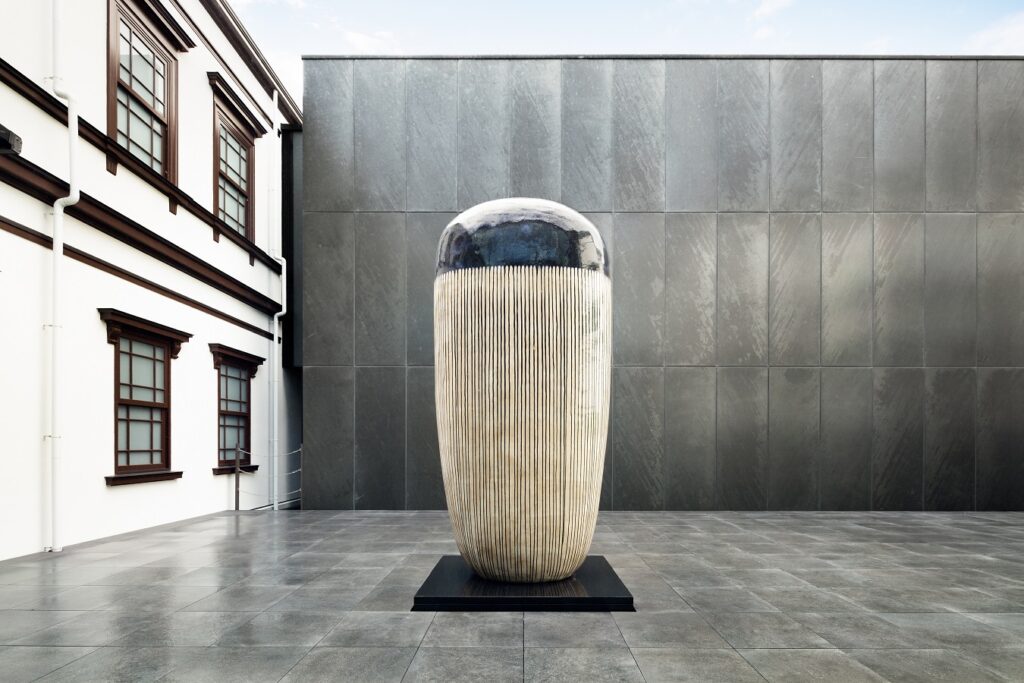Watch, Read, Listen
Reacent Additions to the Collection Newsletter of The National Museum of Modern Art, Tokyo Kaneko Jun, Untitled 13-09-04
BackAlthough the size and texture of this piece may be difficult to imagine from a flat image, this ceramic sculpture stands more than three meters tall. As a piece of ceramic art, the piece needed to be fired in a kiln. And rather than being assembled from smaller components fired separately, this sculpture was fired as a single piece,
Kaneko Jun was born in Nagoya in Aichi Prefecture and traveled to the United States to study painting in Los Angeles in 1963. He became attracted to the world of ceramics when he happened to meet a collector of contemporary ceramics and was impressed by the pieces in his collection. He studied the fundamentals of ceramics at university. American ceramics at the time already had a history of works inspired by abstract expressionist painters and their works, and Kaneko’s university teachers were also strongly influenced by this trend. Although the material was clay, the sculptural pieces these ceramicists produced were marked by expressive, sculptural forms with a strong sense of emotion, decorated with great freedom.
In 1983, Kaneko started the “Omaha Project” in a disused brick factory in Omaha, Nebraska, in which he set out to challenge the limits of scale in ceramics. Using a large kiln in this massive former factory, he succeeded in producing a series of giant works that were as much as 1.8 meters tall and weighed 4 to 5 tons. He called these the dango series, after the Japanese word for dumpling. In the years that followed, Kaneko developed a wide-ranging creative career from his studio in Omaha, creating works that ranged from ceramics marked by striped and dot designs to paintings, works made out of glass, and even opera sets and costumes.
This piece belongs to the dango series produced in Kaneko’s Omaha studio, characterized by a soft, rounded form. One might see the size of the piece as symbolic of the vast scale of the United States. In creating large ceramics in Japan, the size of a piece is strongly influenced by the size of the kiln used for the firing. When making a large ceramic piece in a small kiln, it must be cut into smaller pieces before drying. Paint and glaze are then added before the component pieces are fired and reassembled. The pieces in the dango series, by contrast, have a strength and impact, and perhaps a kind of fascination, that comes from being made and fired as single pieces in a large kiln. Standing tall in the space, this piece is imbued with a commanding, monumental presence.
Today, this piece welcomes visitors from its position in the courtyard in front of the main entrance of the National Crafts Museum, which reopened in its new location in Kanazawa in October 2020 The vivid contrast between the sculpture’s blue and white forms a vivid, luminous contrast with the dark gray tones of the courtyard.
Kanazawa, where the weather changes rapidly and unpredictably, is known for its large number of cloudy days and low hours of sunlight. The deep blue on the upper part of this sculpture mirrors the shifting colors of the sky, while the stripes on the torso are reminiscent of the rain that falls as a blessing from the heavens. During the winter months, we have also enjoyed seeing the sculpture wearing a cap of snow. I hope visitors will take the time to experience how the expressions on this remarkable piece change with the weather and the time of day.
(Gendai no me, Newsletter of The National Museum of Modern Art, Tokyo No.635)
Release date :



